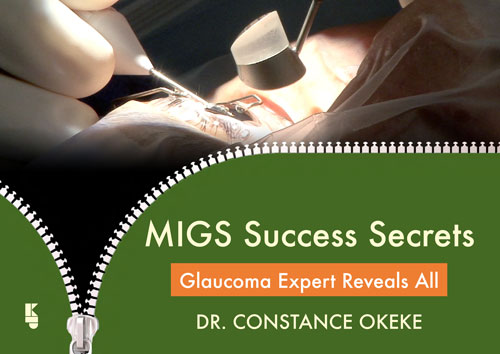Available MIGS:
Removal of trabecular meshwork
The outer trabecular meshwork (TM) and inner wall of Schlemm’s canal (IWSC) are major sites of resistance to outflow of aqueous humor. One important MIGS mechanism of action is removing the TM and IWSC to allow aqueous humor to drain directly into the exposed outflow collector channels of Schlemm’s canal (SC). This can be performed with partial removal of TM or and IWSC or complete. The techniques/devices that utilize this action are: Trabectome, Gonioscopy-Assisted Transluminal Trabeculotomy (GATT), Trab360 and the Kahook Dual Blade.

Trabectome
Trabectome (Neomedix) was the first MIGS procedure, available commercially in 2006. Though incisions into SC (goniotomies and trabeculotomies) have been performed for decades the Trabectome device provides a unique ab-interno approach to the angle through a temporal clear corneal incision. The features of the device with electro-ablation combined with irrigation and aspiration of debris with a protective foot plate to safely remove a strip of trabecular meshwork without damaging the surrounding tissue (scleral wall and collector channel ostia) makes this technique very distinctive.
Watch a video of Trabectome surgery.
Read more about the Trabectome procedure in an article in Ophthalmology Managment, entitled, “Tackling Glaucoma One Trabectome at a Time“.
GATT (Gonioscopy-Assisted Transluminal Trabeculotomy)
GATT (Gonioscopy-Assisted Transluminal Trabeculotomy) is a MIGS technique that was first reported in 2014 as a modification of trabeculotomy with a clear corneal ab-interno approach instead of the traditional conjunctival ab-externo entry (Grover et al., 2014). After entry into the anterior chamber (AC), an i-Track catheter (Ellex) is entered through TM into SC and passed for 360 degrees, then pulled to excise TM and unroof SC.
Watch a video of GATT surgery
Read more about the GATT procedure in an article in EyeWorld, entitled, “Shedding Light on GATT“.
Trab360
The Trab360 was released in early 2015 by a newly-developed company, Sight Sciences. This non-powered device features an access cannula, a flexible injection tube and a control wheel that advances and retracts the injection tube (Fig 3). The Trab360 device enters the AC through a clear corneal incision, pierces through TM, and then once the injection tube has been fully advanced into SC, the TM is manually cut by pulling the injection tube internally (Fig 4). This can be done in one direction for 180 degrees or in both directions for a total of 360 degrees.
Watch a video of Trab360 surgery
Read more about the Trab360 procedure in an article in EyeWorld, entitled, “GATT-lite on Tap“.
Kahook Dual Blade (KDB)
The Kahook Dual Blade (KDB) was recently FDA cleared in the fall of 2015 (New World Medical) and engineered to excise TM tissue using precision micro-machining and laser-cutting technology. One of its key features is a ramp, that puts the TM on stretch as the device is advanced, which aids in the clean excision of the TM with the parallel blades on either side.
Watch a video of Kahook Dual Blade surgery
Read more about the Kahook procedure in an article in Glaucoma Today, entitled, “Goniotomy with Dual Blade“.

